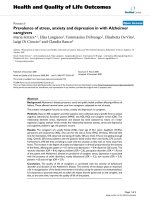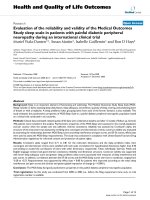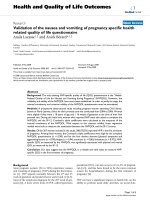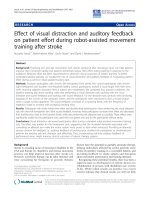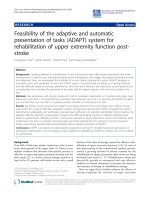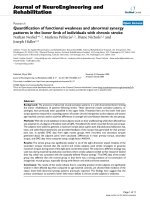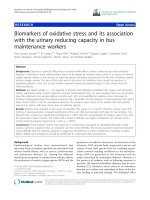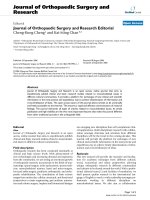Báo cáo hóa học: " Department of Electrical Engineering and Computer " docx
Bạn đang xem bản rút gọn của tài liệu. Xem và tải ngay bản đầy đủ của tài liệu tại đây (628.64 KB, 3 trang )
EURASIP Journal on Wireless Communications and Networking 2005:4, 459–461
c
2005 Hindawi Publishing Corporation
Editorial
Biao Chen
Department of Electrical Engineering and Computer Science, Syracuse University, Syracuse, NY 13244, USA
Email:
Wendi B. Heinzelman
Department of Electrical and Computer Engineering, University of Rochester, Rochester, NY 14627, USA
Email:
Mingyan Liu
Department of Electrical Engineering and Computer Science, University of Michigan, Ann Arbor, MI 48109-2122, USA
Email:
Andrew T. Campbell
Department of Electrical Engineering and Center for Telecommunications Research, Columbia University, NY 10027, USA
Email:
Recent advances in integrated circuits and in digital wire-
less communication technologies have enabled the design
of wireless sensor networks (WSN) to facilitate the joint
processing of spatially and temporally distributed informa-
tion. Such networks immensely enhance our ability to un-
derstand and evaluate complex systems and environments.
Using wireless connections for sensor networks offers in-
creased flexibility in deployment and reconfiguration of
the networks and reduces infrast ructure cost. These advan-
tages enable WSN applications in areas ranging from battle-
field surveillance to environment monitoring and control to
telemedicine.
Enormous challenges in the understanding of sensor net-
works presently impede deployment of many of the envis-
aged applications. In particular, for WSN that employ in situ
unattended sensors, physical constraints, including those of
power, bandwidth, and cost, have presented significant chal-
lenges as well as research opportunities in the field. Of par-
ticular interest to this special issue are topics related to the
communications and networking aspects of WSN. Indeed,
one of the major concerns in sensor networks is maintaining
connectivity and networking functions with geographically
dispersed sensor nodes under stringent resource constraints.
This is further exacerbated by the volume of data generated
by the sensors, which is disproportionately large compared
with the network capacity. The papers in this special issue
arereflectionsofsomeoftheseissues.
Sensor networks are typically built to perform some
system-wide missions, that is, collective inference tasks that
involve all sensor nodes. Examples include detection of an
event and estimation of a parameter or a process. The first
three papers are concerned with designing such WSN. The
first paper, coauthored by Niu and Varshney, considers the
detection of an event in sensor networks with a random
number of sensors. High network density and limited band-
width impose a severe constraint on the number of bits each
sensor can transmit, and the authors treat the extreme case
where a single bit is sent from each sensor. Under the as-
sumption of a Poisson model on the number of sensors, a
simple counting rule is proposed at the fusion center to strike
a balance between performance and requirement on a pri-
ori information. This work demonstrates that for large-scale
heterogeneous sensor networks, heuristics based on intuition
often trump theoretically optimal processing that is typically
too demanding in its requirement. Under the same network
architecture, that is, a number of sensors communicating
with a single fusion center, the second paper, by Krasnopeev
et al. treats an estimation problem where the unknown sig-
nal is corrupted by spatially correlated additive noises. Again,
bandwidth constraints dictate that each sensor sends a finite
number of bits to the fusion center. By exploiting the spatial
correlation of the noise in terms of its covariance matrix, the
minimum energy quantizer design is reformulated as a con-
vex optimization problem and hence can be solved efficiently
460 EURASIP Journal on Wireless Communications and Networking
using standard convex programming. Taking the problem
one step further, the third paper, coauthored by Del Ser et al.
deals with the estimation of a random process. Specifically,
two binary sources, whose correlation is modeled by a hidden
Markov process, are transmitted and the receiver is assumed
to reliably recover one of them. This then serves as side in-
formation for the decoding of the other. It was demonstrated
that the hidden Markov model parameters and the transmit-
ted source can be jointly recovered via iterative decoding.
A perennial problem encountered in large-scale sensor
networks is medium access control (MAC): the lack of a cen-
tral node and the stringent bandwidth and other resource
constraints make it an extremely difficult problem. In the
paper by Yang et al., the authors consider information re-
trieval and processing problems in the SENMA (sensor net-
works with mobile access) network architecture, w h ere data
generated by ground sensors are collected by mobile access
points (e.g., unmanned aerial vehicles). Three MAC proto-
cols are proposed to produce desired data-retrieval patterns,
so as to minimize the reconstruction distortion. These MAC
protocols integrate random access by the sensor nodes and
the ability of the mobile access points to selectively acti-
vate subsets of the sensor field. For a more complicated net-
work model involving multihops, the paper by Cristescu and
Servetto describes a solution to the rate control problem at a
relay node with partial state information at each source node.
The solution reveals an interesting interplay between stabil-
ity and efficiency; it also provides a distributed medium ac-
cess control mechanism such that each node can indepen-
dently decide when it should transmit a packet without com-
plete knowledge of the network state information. Multi-
hop transmission is also considered in the paper by Haap-
ola et al., where an energy dissipation model is proposed to
evaluate carrier-sense multiple-access-based MAC protocols.
Three different MAC protocols are analyzed with this model
and the authors demonstrate how the model can be used
to determine when multihop forwarding is more energy-
efficient than single-hop transmission in wireless sensor net-
works.
An important performance measure in sensor networks
is the throughput capacity. The paper by Li and Dai consid-
ers the tradeoff between throughput and energy efficiency
for a reachback channel where multiple sensors send infor-
mation to an access node. Allowing for an advanced detec-
tion scheme at the multiple-antenna receiver, typically feasi-
ble for the reachback channel as the access node is not sub-
ject to stringent constraints, the authors compare two MAC
schemes, round-robin and slotted-Aloha, both in through-
put and in energy consumption. It was shown that mul-
tiuser scheduling brings significant gain in a fading envi-
ronment, an observation that corroborates other s tudies in
wireless networks with fading channels. The paper by Liu
and Haenggi studies throughput for a multihopped network
using slotted-Aloha. It was shown that while a regular net-
work topology exhibits only marginal performance gain over
a random topology in terms ofper-link throughput, it does
have significant advantages if the end-to-end throughput is
of concern.
Finally, Du and Lin discuss in their paper a new node
scheduling scheme for heterogeneous sensor networks that
provide increased redundancy in certain key areas. Their ap-
proach, which utilizes a clustering scheme with high-end
cluster head nodes that perform the scheduling of all nodes
in their cluster, is energy-efficient by ensuring that only the
necessary sensor nodes are turned on to achieve the desired
coverage in each cluster.
We would like to thank the individuals who participated
in the review process; their dedication has ensured the quality
of this special issue and the timeliness of its publication. We
also would like to thank the authors who have contributed
to this special issue for their effort in abiding to the strict
deadlines. We hope that this collection of papers will provide
some timely research results and contribute to the literature
of this very exciting area.
Biao Chen
Wendi B. Heinzelman
Mingyan Liu
Andrew T . Campbell
Biao Chen received his B.E. and E.E. de-
grees in electrical engineering from Ts-
inghua University, Beijing, China, in 1992
and 1994, respectively. From 1994 to 1995,
he worked at AT&T (China) Inc., Beijing,
China, before he joined the University of
Connecticut, Storrs, where he received his
M.S. degree in statistics and Ph.D. degree in
electrical engineering, in 1998 and 1999, re-
spectively. From 1999 to 2000 he was with
Cornell University as a Postdoc Research Associate. Since 2000, he
has been with Syracuse University, Sy racuse, NY, as an Assistant
Professor w ith t he Department of Electrical Engineering and Com-
puter Science. His area of interest mainly focuses on signal pro-
cessing for wireless sensors and ad hoc networks and on multiuser
MIMO systems.
Wendi B. Heinzelman is an Assistant Pro-
fessor in the Department of Electrical and
Computer Engineering at the University of
Rochester. She received a B.S. degree in elec-
trical engineering from Cornell University
in 1995 and the M.S. and Ph.D. degrees in
electrical engineering and computer science
from MIT in 1997 and 2000, respectively.
Her current research interests lie in the areas
of wireless communications and network-
ing, mobile computing, and multimedia communication. She re-
ceived the NSF CAREER Award in 2005 for her research on cross-
layer architectures for wireless sensor networks, and she received
the ONR Young Investigator Award in 2005 for her work on balanc-
ing resource utilization in wireless sensor networks. She is a Mem-
ber of Sigma Xi, the IEEE, and the ACM.
Editorial 461
Mingyan Liu received her B.S. degree in
electrical engineering in 1995 from Nan-
jing University of Aeronautics and Astro-
nautics, Nanjing, China, the M.S. degree in
systems engineering, and the Ph.D. degree
in electrical engineering from the Univer-
sity of Maryland, College Park, in 1997 and
2000, respectively. She joined the Depart-
ment of Electrical Engineering and Com-
puter Science, the University of Michigan,
Ann Arbor, in September 2000, where she is currently an Assis-
tant Professor. Her research interests are in performance modeling,
analysis, energy-efficiency, and resource allocation issues in wire-
less mobile ad hoc networks, wireless sensor networks, and ter-
restrial satellite hybrid networks. She is the recipient of the 2002
NSF CAREER Award and the University of Michigan Elizabeth C.
Crosby Research Award in 2003.
Andrew T. Campbell is an Associate Professor of electrical engi-
neering at Columbia University, and a member of the COMET
Group. He is working on emerging architectures and programma-
bility for wireless networks. He received his Ph.D. degree in com-
puter science in 1996, and the NSF CAREER Award for his re-
search in programmable mobile networking in 1999. Prior to join-
ing academia he spent 10 years working on transport and operating
systems issues in industry. He spent his sabbatical year (2003–2004)
at the Computer Lab, Cambridge University, as an EPSRC Visiting
Fellow.


